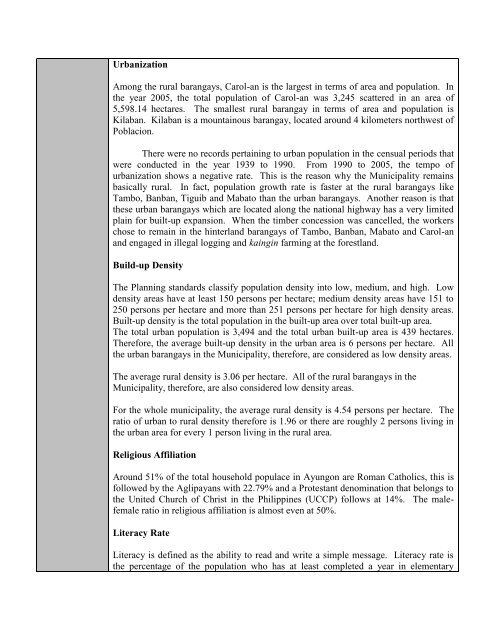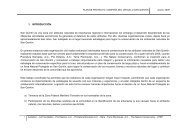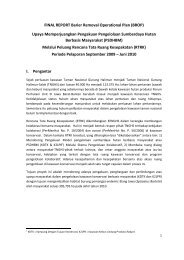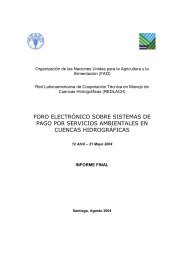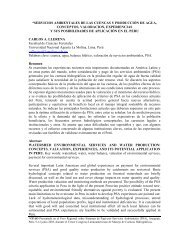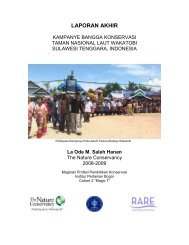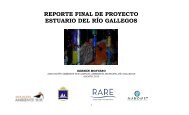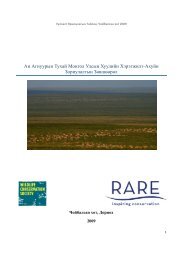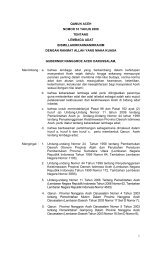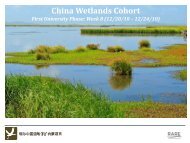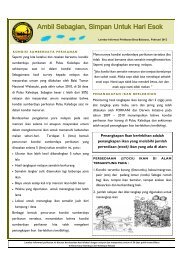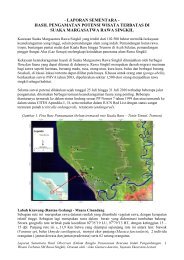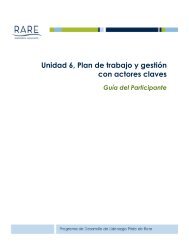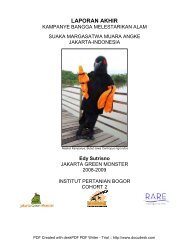Section Inputs Project Scope Country Philippines ... - RarePlanet
Section Inputs Project Scope Country Philippines ... - RarePlanet
Section Inputs Project Scope Country Philippines ... - RarePlanet
Create successful ePaper yourself
Turn your PDF publications into a flip-book with our unique Google optimized e-Paper software.
Urbanization<br />
Among the rural barangays, Carol-an is the largest in terms of area and population. In<br />
the year 2005, the total population of Carol-an was 3,245 scattered in an area of<br />
5,598.14 hectares. The smallest rural barangay in terms of area and population is<br />
Kilaban. Kilaban is a mountainous barangay, located around 4 kilometers northwest of<br />
Poblacion.<br />
There were no records pertaining to urban population in the censual periods that<br />
were conducted in the year 1939 to 1990. From 1990 to 2005, the tempo of<br />
urbanization shows a negative rate. This is the reason why the Municipality remains<br />
basically rural. In fact, population growth rate is faster at the rural barangays like<br />
Tambo, Banban, Tiguib and Mabato than the urban barangays. Another reason is that<br />
these urban barangays which are located along the national highway has a very limited<br />
plain for built-up expansion. When the timber concession was cancelled, the workers<br />
chose to remain in the hinterland barangays of Tambo, Banban, Mabato and Carol-an<br />
and engaged in illegal logging and kaingin farming at the forestland.<br />
Build-up Density<br />
The Planning standards classify population density into low, medium, and high. Low<br />
density areas have at least 150 persons per hectare; medium density areas have 151 to<br />
250 persons per hectare and more than 251 persons per hectare for high density areas.<br />
Built-up density is the total population in the built-up area over total built-up area.<br />
The total urban population is 3,494 and the total urban built-up area is 439 hectares.<br />
Therefore, the average built-up density in the urban area is 6 persons per hectare. All<br />
the urban barangays in the Municipality, therefore, are considered as low density areas.<br />
The average rural density is 3.06 per hectare. All of the rural barangays in the<br />
Municipality, therefore, are also considered low density areas.<br />
For the whole municipality, the average rural density is 4.54 persons per hectare. The<br />
ratio of urban to rural density therefore is 1.96 or there are roughly 2 persons living in<br />
the urban area for every 1 person living in the rural area.<br />
Religious Affiliation<br />
Around 51% of the total household populace in Ayungon are Roman Catholics, this is<br />
followed by the Aglipayans with 22.79% and a Protestant denomination that belongs to<br />
the United Church of Christ in the <strong>Philippines</strong> (UCCP) follows at 14%. The malefemale<br />
ratio in religious affiliation is almost even at 50%.<br />
Literacy Rate<br />
Literacy is defined as the ability to read and write a simple message. Literacy rate is<br />
the percentage of the population who has at least completed a year in elementary


